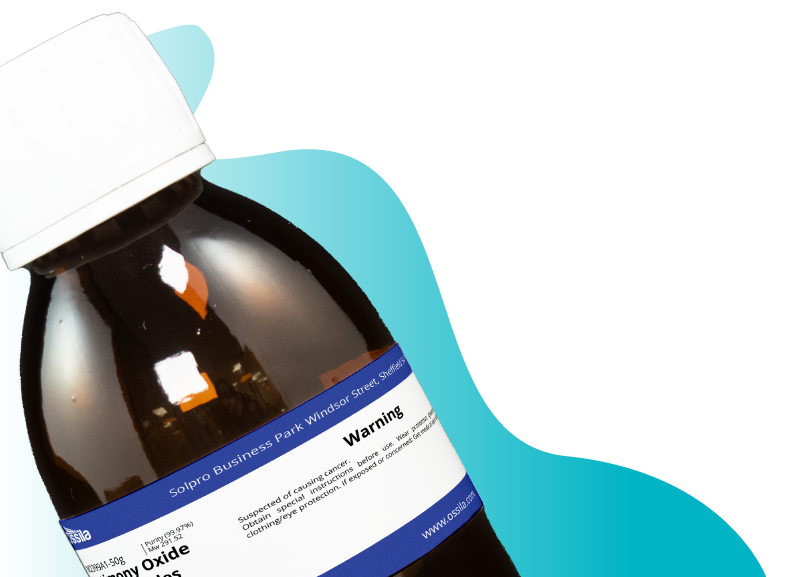Molybdenum Disulfide Few-Layer Film
CAS Number 1317-33-5
2D Materials, Low Dimensional Materials, Materials, Molybdenum Disulfide (MoS2), Transition Metal Chalcogenides (TMCs), Transition Metal Dichalcogenides (TMDs)MoS2 Few-Layer Film, high purity 2D material
For applications in nanoelectronics, optoelectronics, and flexible devices
Technical Data | MSDS | Applications | Literature and Reviews | Related Products | Resources and Support
Few-layer molybdenum disulfide (MoS2), CAS number 1317-33-5, is considered to be one of the most attractive materials for next-generation nanoelectronics. This is due to its silicon-level charge mobility and high current on/off ratio in thin-film transistors. Compared to monolayer MoS2 (which needs a deposition of an additional high-k dielectric layer such as HfO2), few-layer MoS2 can be operated on its own. This makes it more appealing for fabricating transistors and other optoelectronic devices.
High Purity
>99% Purity Molybdenum Disulfide Few-Layer Film
Worldwide shipping
Quick and reliable shipping
Low Cost
Low Cost Molybdenum Disulfide
Applications
Applications in nanoelectronics, optoelectronics, and flexible devices
Technical Data
| CAS Number | 1317-33-5 |
| Chemical Formula | MoS2 |
| Molecular Weight | 160.07 g/mol |
| Bandgap | 1.23 eV |
| Synonyms | Molybdenum sulfide, Molybdenum disulphide, Molybdenum(IV) sulfide |
| Classification / Family | Transition metal dichalcogenides (TMDCs), 2D semiconductor materials, Nano-electronics, Nano-photonics, Materials science |
Product Details
| Substrate | SiO2/Si | Sapphire |
| Product Code | M2167F11 | M2168F11 |
| Size | 1 cm × 1 cm* | 1 cm × 1 cm* |
| Growth Method | CVD synthesis | CVD synthesis |
| Appearance | Transparent | Transparent |
| Purity | >99% | >99% |
| Transparency | >97% | >97% |
| Coverage | >95% | >95% |
| Number of Layers | 2 - 5 | 2 - 5 |
| Sheet Resistance | N/A | N/A |
| Transfer Method | Directly grown | Directly grown |
| Substrate Thickness | 300 nm (oxide layer) | 300 µm |
*Other sizes available: up to 2 cm × 2 cm or 2 inches in diameter (sapphire substrate only).
High-quality molybdenum disulfide (MoS2) few-layer films are available on two different substrates as standard: SiO2/Si and Sapphire. Different substrates of few-layer MoS2 films, including Glass, Silicon and Quartz are also available via custom order.
Please contact us for more information regarding custom products.
Pricing Table
| Substrate | Product code | Size | Quantity (EA) | Price |
|---|---|---|---|---|
| SiO2/Si | M2167F11 | 1 cm × 1 cm | 1 | £420 |
| Sapphire | M2168F11 | 1 cm × 1 cm | 1 | £420 |
MSDS Documents
 Molybdenum disulfide monolayer film on silicon
Molybdenum disulfide monolayer film on silicon
 Molybdenum disulfide monolayer film on sapphire
Molybdenum disulfide monolayer film on sapphire
Applications
Molybdenum disulfide (MoS2) few-layer film, with an impressive direct band gap of 1.9 eV in the monolayer regime, has promising potential applications in nanoelectronics, optoelectronics, and flexible devices.
MoS2 few-layer films can also be made into heterostructures for energy conversation and storage devices, and used as a catalyst for hydrogen revolution reactions (HER).
Synthesis
High quality molybdenum disulfide (MoS2) few-layer films were grown directly on the substrates (SiO2/Si and Sapphire) by chemical vapour deposition (CVD) method. The films were later transferred to the desired substrates using wet chemical transfer process.
Usage
MoS2 few-layer film can be used in research purposes such as microscopic analysis, photoluminescence and Raman spectroscopy studies. Few-layer MoS2 film can also be transferred to other substrates.
Literature and Reviews
- Tunable Charge-Trap Memory Based on Few-Layer MoS2, E. Zhang et al., ACS Nano, 9 (1), 612–619 (2015); DIO: 10.1021/nn5059419.
- Few-Layer MoS2: A Promising Layered Semiconductor, R. Ganatra et al., ACS Nano, 8 (5), 4074–4099 (2014); DOI: 10.1021/nn405938z.
- Few-Layer MoS2 with High Broadband Photogain and Fast Optical Switching for Use in Harsh Environments, D. Tsai et al., ACS Nano, 7 (5), 3905–3911 (2013); DOI: 10.1021/nn305301b.
Related Products
We stock a wide range of 2D materials available to purchase online. Please contact us if you cannot find what you are looking for.



